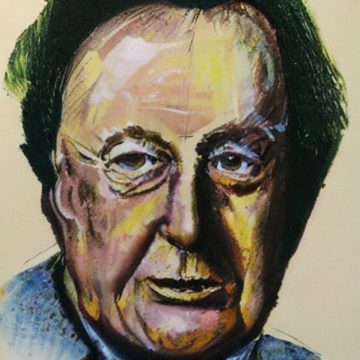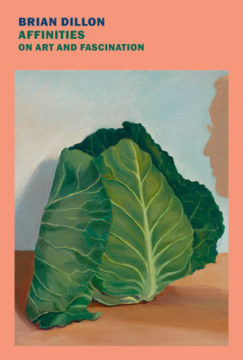Category: Recommended Reading
Jesse Treviño (1946 – 2023) Artist
Wayne Shorter (1933 – 2023) Jazz Saxophonist And Composer
Sunday Poem
“Spring and All”
By the road to the contagious hospital
under the surge of the blue
mottled clouds driven from the
northeast—a cold wind. Beyond, the
waste of broad, muddy fields
brown with dried weeds, standing and fallen
patches of standing water
the scattering of tall trees
All along the road the reddish
purplish, forked, upstanding, twiggy
stuff of bushes and small trees
with dead, brown leaves under them
leafless vines—
Lifeless in appearance, sluggish
dazed spring approaches–
They enter the new world naked,
cold, uncertain of all
save that they enter. All about them
the cold, familiar wind–
Now the grass, tomorrow
the stiff curl of wildcarrot leaf
One by one objects are defined–
It quickens: clarity, outline of leaf
But now the stark dignity of
entrance–Still, the profound change
has come upon them: rooted, they
grip down and begin to awaken
by William Carlos Williams
from Spring and All
Contact Publishing Co., 1923
Saturday, March 4, 2023
The IMF Trap
 Devaka Gunawardena , Niyanthini Kadirgamar, and Ahilan Kadirgamar in Phenomenal World:
Devaka Gunawardena , Niyanthini Kadirgamar, and Ahilan Kadirgamar in Phenomenal World:
Massive demonstrations that swept Sri Lanka last year exposed the serious challenges at the heart of the global economy. In July 2022, former President Gotabaya Rajapaksa was forced to flee the country, only a few months after announcing a hasty default of Sri Lanka’s foreign debt obligations. He faced a wall of opposition as the nation suffered infamous kilometers-long fuel queues, power outages, and food and medicinal shortages, crippling everyday life.
In the months since, the current government led by Ranil Wickremesinghe—allied with the party of the disgraced Rajapaksa family—has appeared savvier than its predecessor, implementing a quota system to manage fuel distribution and end the queues. However, the government has also tripled fuel prices, which has severely dampened demand. Fuel consumption is half of what it was a year ago, bringing economic activity to a grinding halt. Inflation has skyrocketed, with food inflation peaking at 94 percent in September 2022. A quarter of Sri Lankans are facing severe food insecurity; household incomes across the board have decreased. The Central Bank dramatically doubled interest rates, making access to credit for economic activity extraordinarily difficult. Rural livelihoods have been disrupted. Many small businesses are collapsing.
More here.
Two Great Losses
 Perry Anderson in New Left Review:
Perry Anderson in New Left Review:
Since the composition of the last issue of the journal, nlr has lost the two most gifted political writers to have ignited its pages over the years, Tom Nairn and Mike Davis. Both were magnitudes whose life and work extended far beyond this journal, requiring consideration by others on another scale. Only that portion of what they achieved which is connected with nlr, not to be exaggerated, and some of the differences between them, are in place here. Death claimed them close together. Did they touch in any other respect? Each was a mind so entirely original that, virtually by definition, it would seem they had little in common. Generation, class, nationality, formation, temperament—all set them quite radically apart. Tom was fourteen years older, born in a small Scottish village, his father headmaster of a nearby school. A natural polymath, he won a privileged education, first in an art college, then studying philosophy at two universities in Britain—Edinburgh and Oxford—thereafter spending time at the apex of higher education in Italy, the Scuola Normale in Pisa, where he acquired fluent Italian.
Returning to England in the early sixties, he earned post-graduate awards and lectured in an art college in London. There he supported the student revolt of 1968, and was dismissed for doing so. For a quarter of a century he never had a teaching job again, and for the rest of his life was always in difficult straits, often in poverty, scraping a nomadic living in places as remote from each other as Amsterdam, Washington, Prague, and finally Melbourne—where, in his seventies, he found employment for a decade in a university ten thousand miles away from where he lived in West Lothian. A Scot to whom conventional English forms of conviviality were foreign in ways that could be mistaken for shyness, he was generally quiet and reserved, and avoided publicity. He could be fierce in print, his mockery scalding; yet he was warm and gentle as a person. Italian released the high spirits in him.
More here.
A Piece of One’s Past
 Kenda Mutongi in Boston Review:
Kenda Mutongi in Boston Review:
You need to do a police investigation,” wrote one of my siblings on our family group chat, “a thorough investigation.” On January 17, 2023, someone set fire to my brother Jumba’s five-acre sugarcane garden. Three days after the fire, my brother received a phone call informing him that thieves had gotten into his compound and broken the cement cover on his borehole and stolen the electric pump.
Jumba’s land is in western Kenya, about sixty miles from the village where we grew up. The area, known as the western highland plateau during the colonial period, was occupied by white settlers who confiscated land from the local Nandi people. After independence the land was redistributed to Kenyans but somehow Luyias (my family is Luyia) and Kikuyus ended up buying most of it, further displacing the original Nandi owners. Since the 1970s the Nandi people have intermittently fought these “outsiders” in attempts to reclaim their land; some of the ethnic tensions have resulted in the loss of life.
More here.
Who Will Power the Climate Revolution?
 Dylan Saba in Jewish Currents:
Dylan Saba in Jewish Currents:
THE UNCOMFORTABLE TRUTH about the struggle to avoid climate catastrophe is that no one has a realistic plan. The challenge itself, as set out by scientific consensus, is relatively straightforward: Reduce carbon emissions, build infrastructure for renewable energy, and protect and restore biodiversity. But achieving these objectives—especially in the tight window we have—requires a degree of foresight and coordination that is incompatible with the political economy of our present. Without a global body to enforce them, state benchmarks are governed only by voluntary treaties, and these commitments can’t withstand the caprices of domestic electorates or the imperative to compete in a global marketplace. Meanwhile, private firms and asset managers are likewise driven to prioritize short-term profits over long-term sustainability. These capitalist incentives are compounded by colonialist ones, which ensure that the very nations responsible for the overwhelming majority of emissions are also the most insulated from the consequences. All in all, those in power have the least to lose from inaction—not a recipe for success.
In the face of this rather dismal state of affairs, every approach to green politics on offer requires a degree of magical thinking—even the supposedly pragmatic liberal strategy, which pins all hope for humanity on persuading elites to adopt a series of woefully insufficient technocratic adjustments.
More here.
‘Affinities’ by Brian Dillon
Anil Gomes at The Guardian:
 Why do some things combine and others separate? Add nitric acid to gold, and nothing happens. Pour on aqua regia, a mixture of nitric and hydrochloric acids, and the gold dissolves. The chemical doctrine of affinity emerged as a way to explain these reactions. In his 1809 novel Elective Affinities, Johann Wolfgang Goethe applied the idea to human relationships. Charlotte and Edward may form a stable union but if Edward has an affinity with young Ottilie – ah, well, then all bets are off.
Why do some things combine and others separate? Add nitric acid to gold, and nothing happens. Pour on aqua regia, a mixture of nitric and hydrochloric acids, and the gold dissolves. The chemical doctrine of affinity emerged as a way to explain these reactions. In his 1809 novel Elective Affinities, Johann Wolfgang Goethe applied the idea to human relationships. Charlotte and Edward may form a stable union but if Edward has an affinity with young Ottilie – ah, well, then all bets are off.
What is an affinity? A little like a crush, I suppose, at least at the beginning. And sometimes just as fleeting. But sometimes more stable, more serious, and more revealing of our ways of engaging with things. Brian Dillon’s writings have always been marked by affinities – for artworks, for writers, even for particular sentences.
more here.
André Aciman and Brian Dillon: ‘Homo Irrealis’
Polaroid’s Secret Showman
Jonathan Allen with Jan Isenbart at Cabinet Magazine:
 In the spring of 1954, Reinhard Müller stepped onto a stage in the German city of Wolfsburg as a volunteer in a magic show. His presence was captured in a small sepia photograph, where he can be seen in conversation with a tuxedoed magician holding the elegant pocket watch that Müller has just entrusted to him. The conjurer is Helmut Ewald Schreiber (1903–1963), better known by his stage name Kalanag. He is in the final stages of a trick called “The Devil’s Mail,” a popular feature of his world-touring magic revue, Simsalabim. A few moments before, Müller’s watch had been reduced to fragments in a mortar by sharp blows of the magician’s wand. In the photograph, Kalanag can be seen returning the now miraculously restored timepiece to its owner. But his watch is not all that Müller will take with him when he leaves the stage. To his delight, he will also carry this snapshot, delivered to him in an envelope by the magician within moments of the very scene that it depicts.
In the spring of 1954, Reinhard Müller stepped onto a stage in the German city of Wolfsburg as a volunteer in a magic show. His presence was captured in a small sepia photograph, where he can be seen in conversation with a tuxedoed magician holding the elegant pocket watch that Müller has just entrusted to him. The conjurer is Helmut Ewald Schreiber (1903–1963), better known by his stage name Kalanag. He is in the final stages of a trick called “The Devil’s Mail,” a popular feature of his world-touring magic revue, Simsalabim. A few moments before, Müller’s watch had been reduced to fragments in a mortar by sharp blows of the magician’s wand. In the photograph, Kalanag can be seen returning the now miraculously restored timepiece to its owner. But his watch is not all that Müller will take with him when he leaves the stage. To his delight, he will also carry this snapshot, delivered to him in an envelope by the magician within moments of the very scene that it depicts.
more here.
Saturday Poem
Aubade:The Morning Beast
Maybe she’s the dew-crystalled web
and the great furred spider inside it.
Maybe she’s bus exhaust and sirens.
You don’t need to know. For certain
she is not worried about haircuts or lists
or televised debates. She is not worried
about certainty. She isn’t here to smooth
anything over. She isn’t here to judge
or forgive. She has fog. She has seven deer
and a massive growling garbage truck.
She does not care about the research
you’ve done. She does not notice
your mouth. She herself doesn’t need one.
She herself doesn’t speak because
speaking goes one way only, is non-
dimensional, air-colored and leafless.
She is all leaves. She is all cisterns
of stone. She towers when she wants to.
Other times she mists-and-murmurs.
She sees you wanting her to absolve you.
She sees you making your sunrise resolutions:
good morning, restraint and improvement!
She finds you sweet, the way you might
find a vole or a small ceramic cactus sweet.
She is a non-translation, a no thank you.
She wants for nothing. She’s insatiable.
Brimless, she’s filled to the brim.
by Catherine Pierce
from the Ecotheo Review
Do no unconscious harm
Rodrigo Perez Ortega in Science:
 EVERYONE HAS prejudices that affect how they perceive and behave with others. And although many people might be aware of some—their explicit or conscious biases—and intentionally try to compensate for them, other hidden ones still lurk and can influence attitudes and interactions. These implicit biases are widespread among health care providers, as Janice Sabin discovered in the late 2000s. In her research back then —as a social welfare Ph.D. student at UW—Sabin had asked 95 doctors from the Department of Pediatrics at Seattle Children’s Hospital to take a test that would determine whether they had a “hidden” bias toward a certain race. “I was terrified,” Sabin, now a biomedical informatics professor at UW, recalls. “This wasn’t just asking them questions about bias and racism, this was actually going into their mind.”
EVERYONE HAS prejudices that affect how they perceive and behave with others. And although many people might be aware of some—their explicit or conscious biases—and intentionally try to compensate for them, other hidden ones still lurk and can influence attitudes and interactions. These implicit biases are widespread among health care providers, as Janice Sabin discovered in the late 2000s. In her research back then —as a social welfare Ph.D. student at UW—Sabin had asked 95 doctors from the Department of Pediatrics at Seattle Children’s Hospital to take a test that would determine whether they had a “hidden” bias toward a certain race. “I was terrified,” Sabin, now a biomedical informatics professor at UW, recalls. “This wasn’t just asking them questions about bias and racism, this was actually going into their mind.”
Sabin used the well-known Implicit Association Test (IAT), which determines how strongly an individual associates a trait—such as race or sexual orientation—with a subjective value, such as “good” or “bad.” The quicker you match each concept to a subjective value, the greater the association and the higher your score, which broadly indicates a stronger implicit association between the trait and value. Sabin found the doctors she tested—a few of them nonwhite—had a clear, unconscious preference for white people over Black people.
More here.
The bikers’ bible
J R Patterson in New Humanist:
 Zen and the Art of Motorcycle Maintenance, published in 1974, was nothing short of a cultural phenomenon. A work of fictionalised autobiography, the book follows its author Robert Pirsig on a long motorcycle ride through the US, from Minnesota across the prairie to Oregon, then down to southern California. The muscles of that skeletal journey are Pirsig’s philosophical musings on the notion of Quality. Pirsig created the concept in order explain the relationship between human values and societal values.
Zen and the Art of Motorcycle Maintenance, published in 1974, was nothing short of a cultural phenomenon. A work of fictionalised autobiography, the book follows its author Robert Pirsig on a long motorcycle ride through the US, from Minnesota across the prairie to Oregon, then down to southern California. The muscles of that skeletal journey are Pirsig’s philosophical musings on the notion of Quality. Pirsig created the concept in order explain the relationship between human values and societal values.
At once both obvious and ephemeral, Quality escapes easy definition. (And brings to mind American supreme court justice Potter Stewart’s comments about pornography: “I know it when I see it.”) In his original formulation, Pirsig describes it, not a little paradoxically, as “a characteristic of thought and statement that is recognised by a non-thinking or intuitive process.” At another juncture, Quality is defined as the event which occurs between the observer and the observed. Pirsig’s search for clarity stretched his mind to the breaking point, ultimately landing him in a psychiatric facility where he was subjected to electroshock therapy.
And yet, the concept has been influential. The book, a bestseller, continues to be read by motorcyclists, philosophers and everyone in between.
More here.
Friday, March 3, 2023
Is it time to hit the pause button on AI?
Gary Marcus and Michelle Rempel Garner at The Road to AI We Can Trust:
 With the use of this new technology exploding into the masses, previously unknown risks being revealed each day, and big tech companies pretending everything is fine, there is an expectation that the government might step in. But so far, legislators have taken little concrete action. And the reality is that even if lawmakers were suddenly gripped with an urgent desire to address this issue, most governments don’t have the institutional nimbleness, or frankly knowledge, needed to match the current speed of AI development.
With the use of this new technology exploding into the masses, previously unknown risks being revealed each day, and big tech companies pretending everything is fine, there is an expectation that the government might step in. But so far, legislators have taken little concrete action. And the reality is that even if lawmakers were suddenly gripped with an urgent desire to address this issue, most governments don’t have the institutional nimbleness, or frankly knowledge, needed to match the current speed of AI development.
The global absence of a comprehensive policy framework to ensure AI alignment – that is, safeguards to ensure an AI’s function doesn’t harm humans – begs for a new approach.
Logically speaking, in this context, there are three options for proceeding.
More here.
Who really discovered DNA’s structure?
Matt Ridley in The Spectator:
 Tuesday 28 February marks the 70th anniversary of – in my view – the most important day in the history of science. On a fine Saturday morning with crocuses in flower along the Backs in Cambridge, two men saw something surprising and beautiful. The double helix structure of DNA instantly revealed why living things were different: a molecule carries self-copying messages from the past to the future, bearing instructions written in a four-letter alphabet about how to synthesise living bodies from food. In the Eagle pub that lunchtime, Francis Crick and James Watson announced to startled fellow drinkers that they had discovered the secret of life.
Tuesday 28 February marks the 70th anniversary of – in my view – the most important day in the history of science. On a fine Saturday morning with crocuses in flower along the Backs in Cambridge, two men saw something surprising and beautiful. The double helix structure of DNA instantly revealed why living things were different: a molecule carries self-copying messages from the past to the future, bearing instructions written in a four-letter alphabet about how to synthesise living bodies from food. In the Eagle pub that lunchtime, Francis Crick and James Watson announced to startled fellow drinkers that they had discovered the secret of life.
More here.
Saad Bhamla on The Fascinating Physics of Insect Pee
Is Europe’s Green Investment Plan the Future of Climate Policy?
Paul Hockenos in Undark:
 THE PASSAGE OF last year’s $369 billion Inflation Reduction Act, which despite its name is essentially a climate protection bill, was remarkable for its suddenness and sheer magnitude. In one stroke, it jacked global climate policy to another dimension, solidified the U.S. as a pacesetter on climate action, and showed the public sector’s willingness to undertake heavy lifting on a scale that had previously been inconceivable.
THE PASSAGE OF last year’s $369 billion Inflation Reduction Act, which despite its name is essentially a climate protection bill, was remarkable for its suddenness and sheer magnitude. In one stroke, it jacked global climate policy to another dimension, solidified the U.S. as a pacesetter on climate action, and showed the public sector’s willingness to undertake heavy lifting on a scale that had previously been inconceivable.
But the Inflation Reduction Act, or IRA, is also notable for its strategic approach. In the form of generous tax incentives, grants, and loan guarantees, it makes available hundreds of billions of dollars to directly subsidize American industry’s buildout of renewable energy sources, electrification, electric cars, hydrogen technology, and other green tech. Rather than capping and pricing carbon emissions to curb greenhouse gas emissions — and using that revenue to spur the economy’s green transformation — the U.S. is wagering that it can spend its way to a clean energy economy: that a big-enough carrot, in other words, will work as well or better than a stick. In that way, the IRA has “redefined the terms of the debate,” as Toby Couture, director of the Berlin-based consulting firm E3 Analytics, told me.
Now it appears the E.U. may be coming around to the American way of thinking.
More here.
Generative AI Is About To Reset Everything, And, Yes It Will Change Your Life
Minute 9: Synecdoche, New York
Grant Maierhofer at 3:AM Magazine:
 I don’t know why but I’m still affected by the death of Philip Seymour Hoffman. I didn’t know him, and I don’t think I’ve even seen all of his work, but his presence is so affecting to me. He doesn’t look like an actor. He struggled with addiction. He got sober young and relapsed. It scares me.
I don’t know why but I’m still affected by the death of Philip Seymour Hoffman. I didn’t know him, and I don’t think I’ve even seen all of his work, but his presence is so affecting to me. He doesn’t look like an actor. He struggled with addiction. He got sober young and relapsed. It scares me.
In Charlie Kaufman’s film we probably have his best work, playing a director putting on productions that grow from Death of a Salesman to an impossibly large thing, but in the ninth minute of the film we just have him talking to his doctor. The doctor asks if he means right as in morally correct or as in accurate. Hoffman’s Caden Cotard says he doesn’t know, maybe accurate, and then we’re with these two for a moment, this awkward moment between someone who is hyper aware of themselves and his doctor, and although there’s always that temptation to simply state anything to keep an appointment moving along, that doesn’t happen, and suddenly both men are forced to sit and think, and it’s uncomfortable but warm.
more here.
